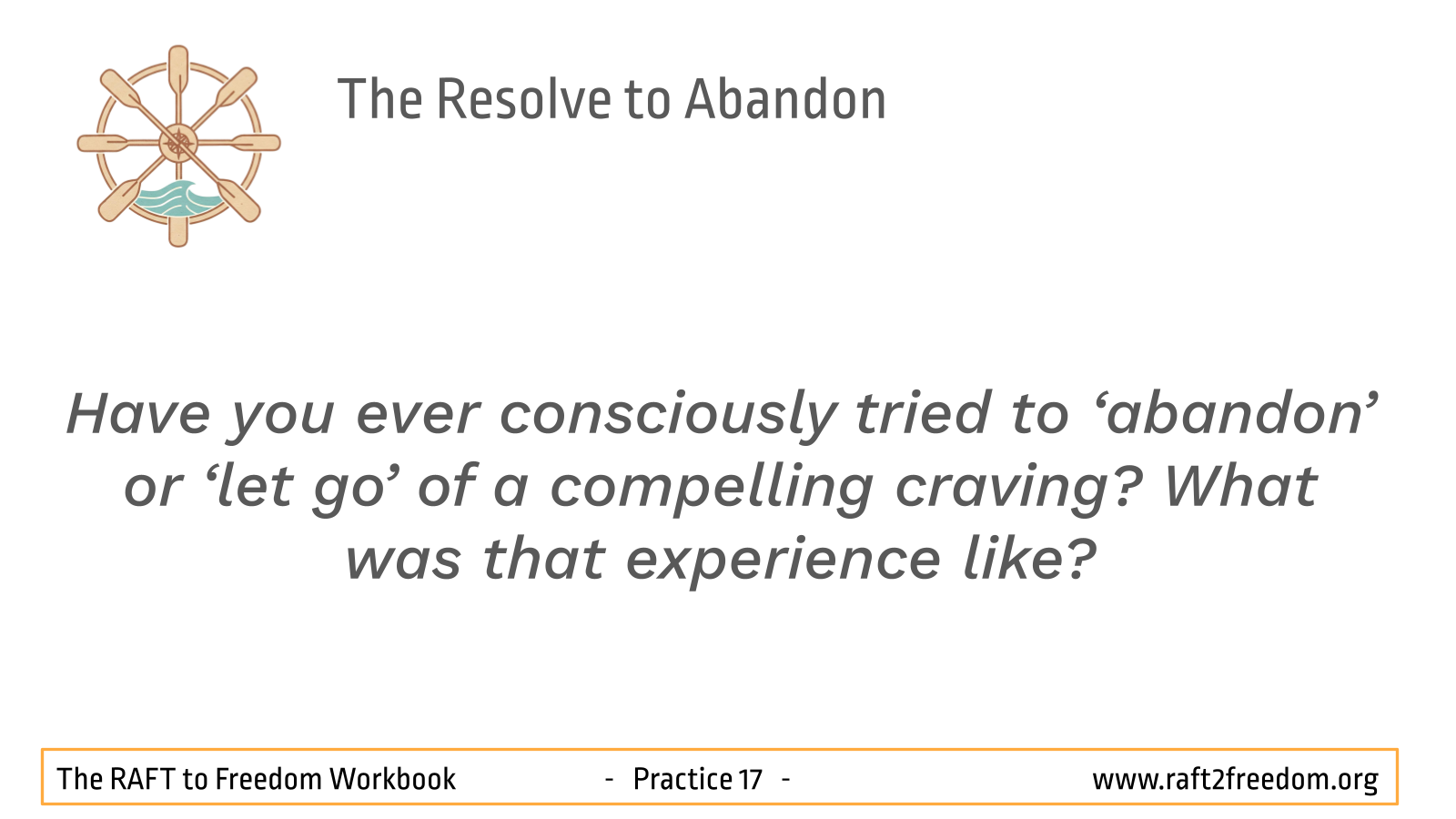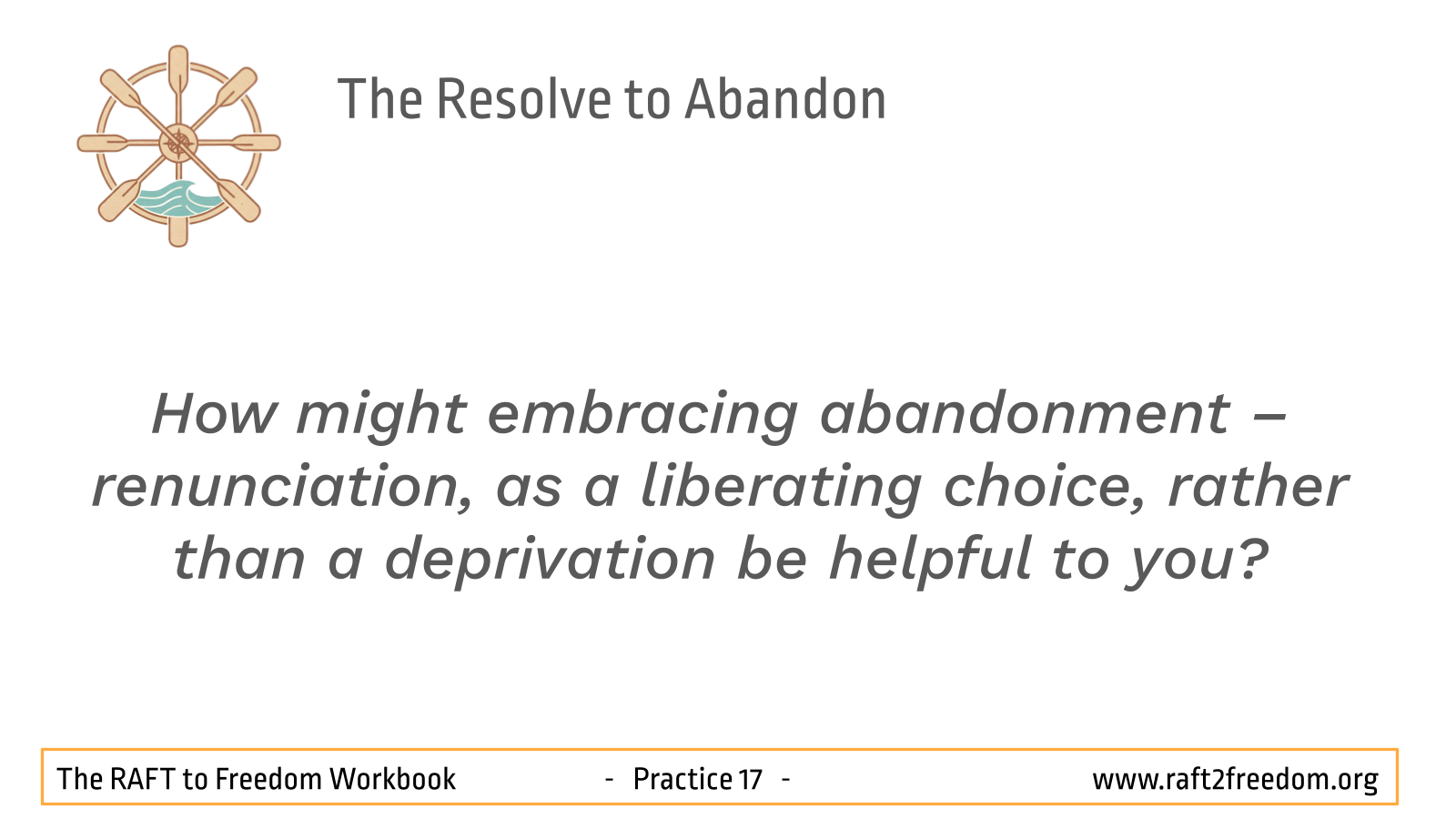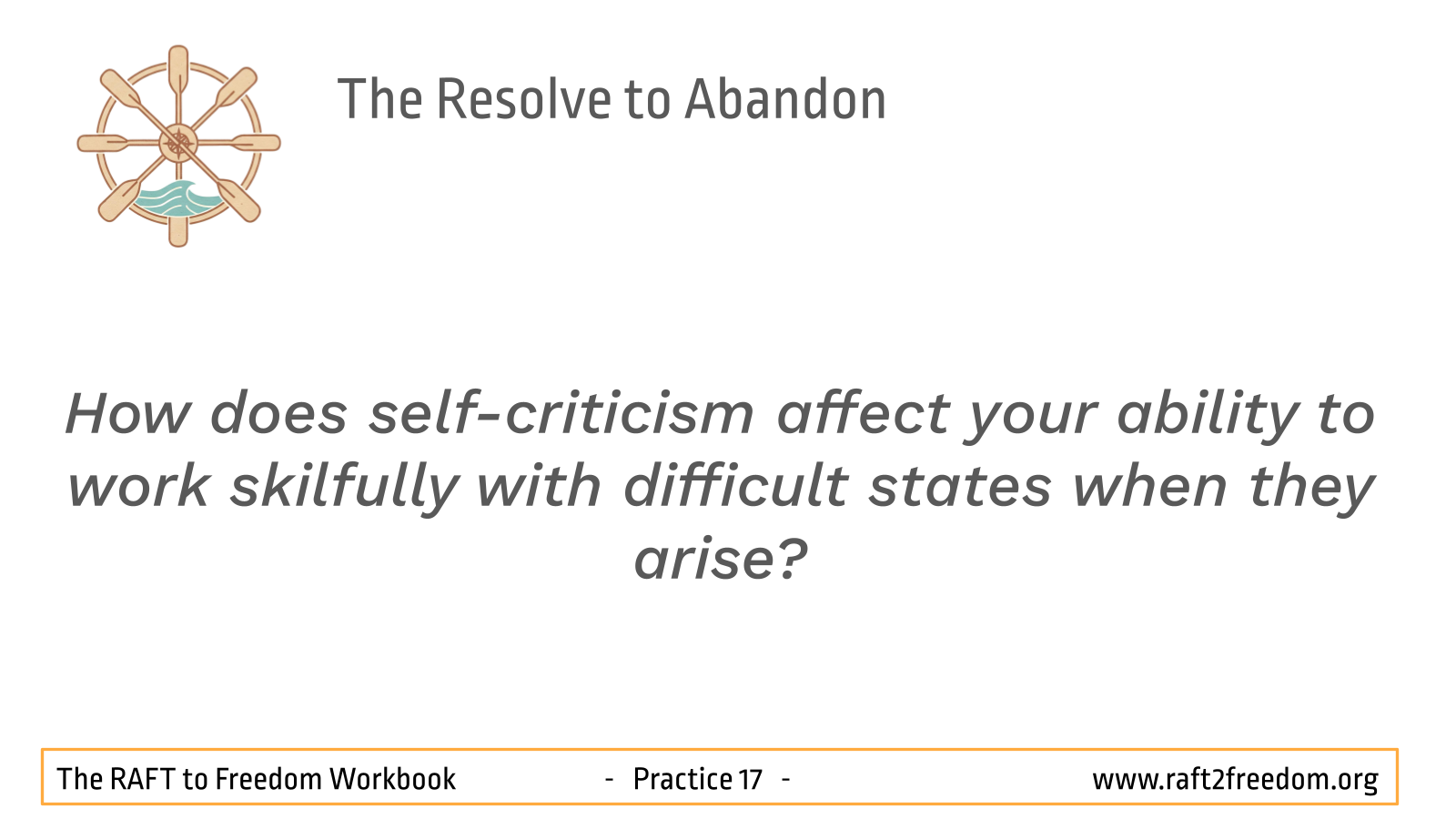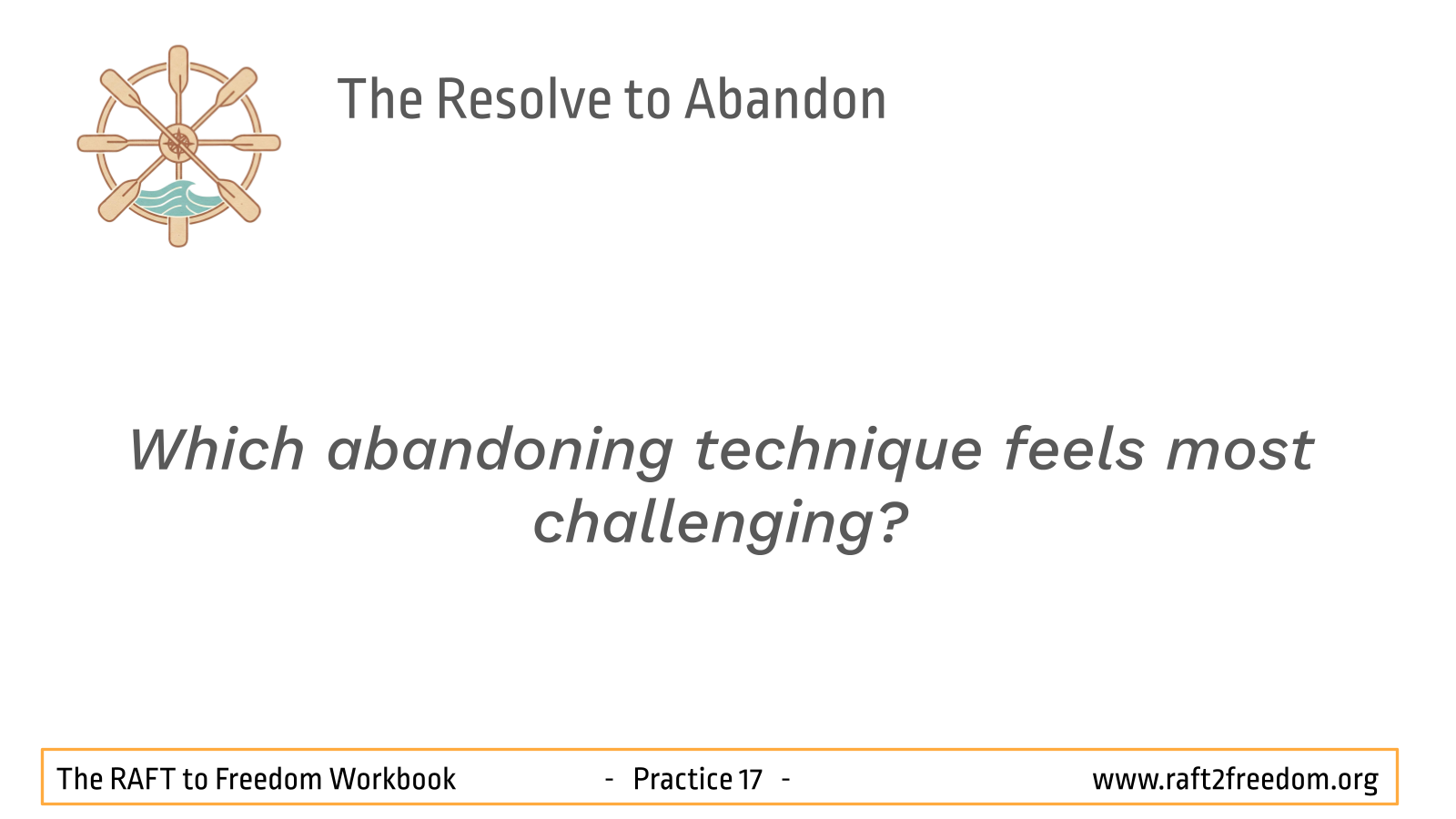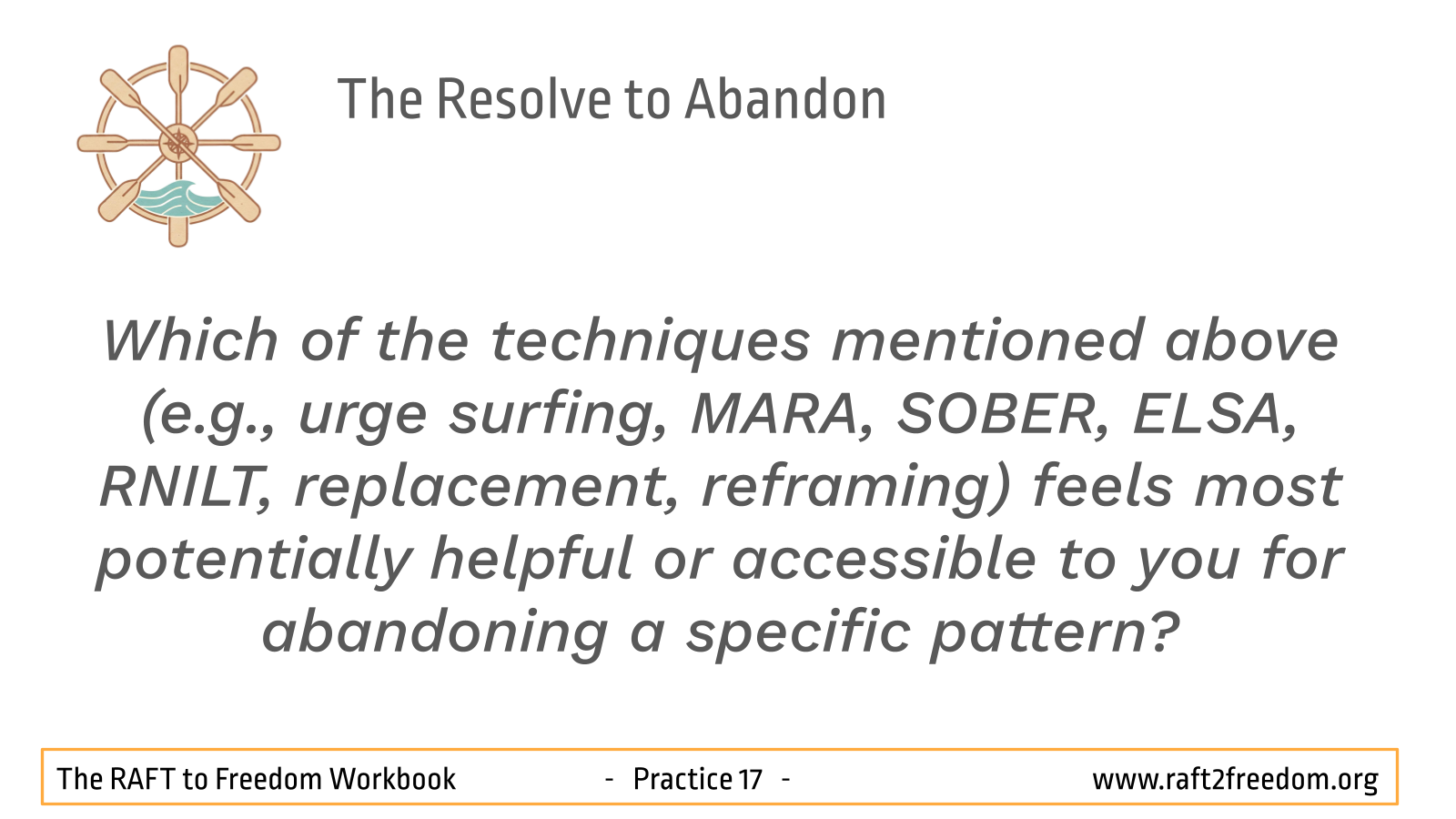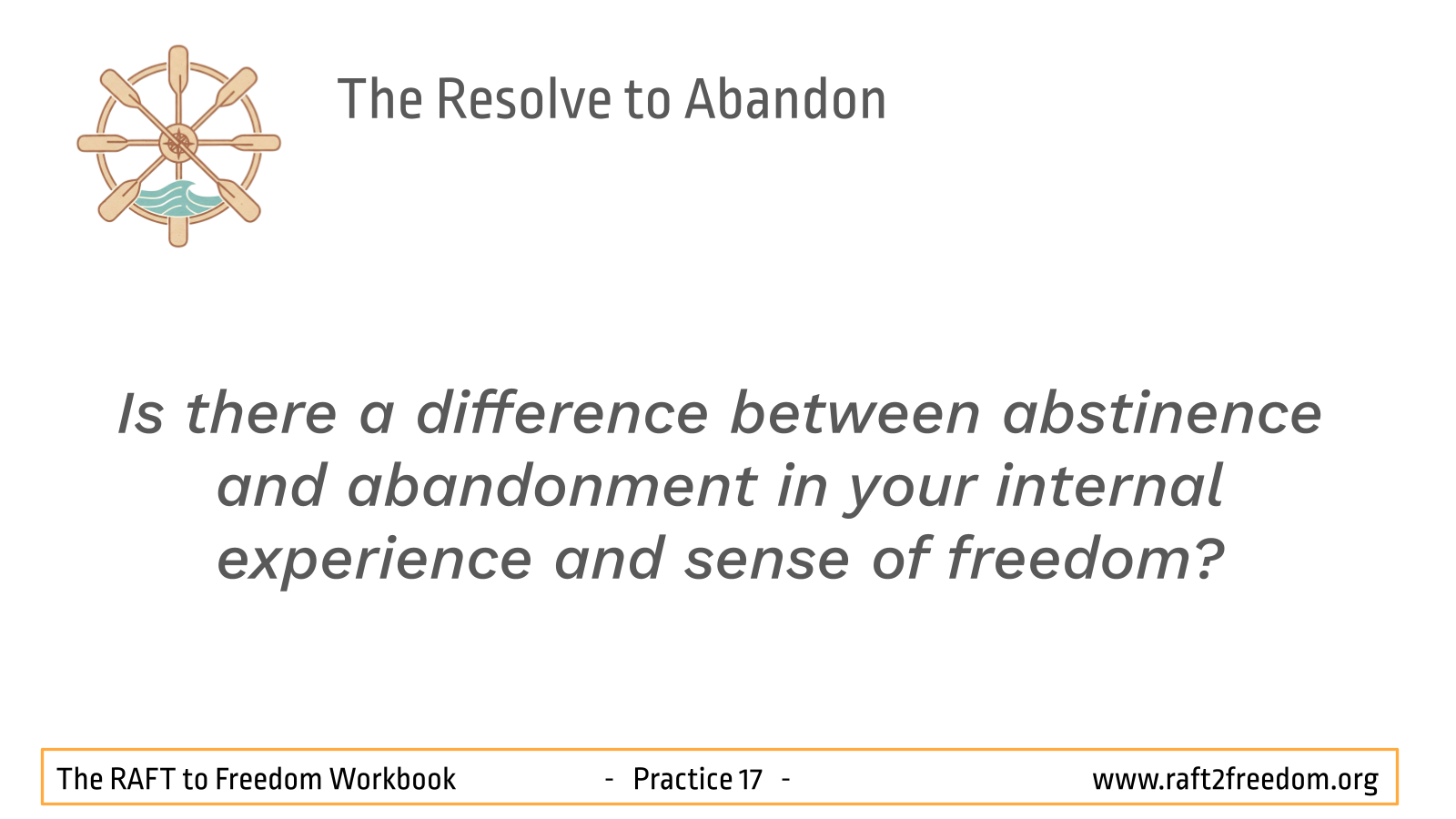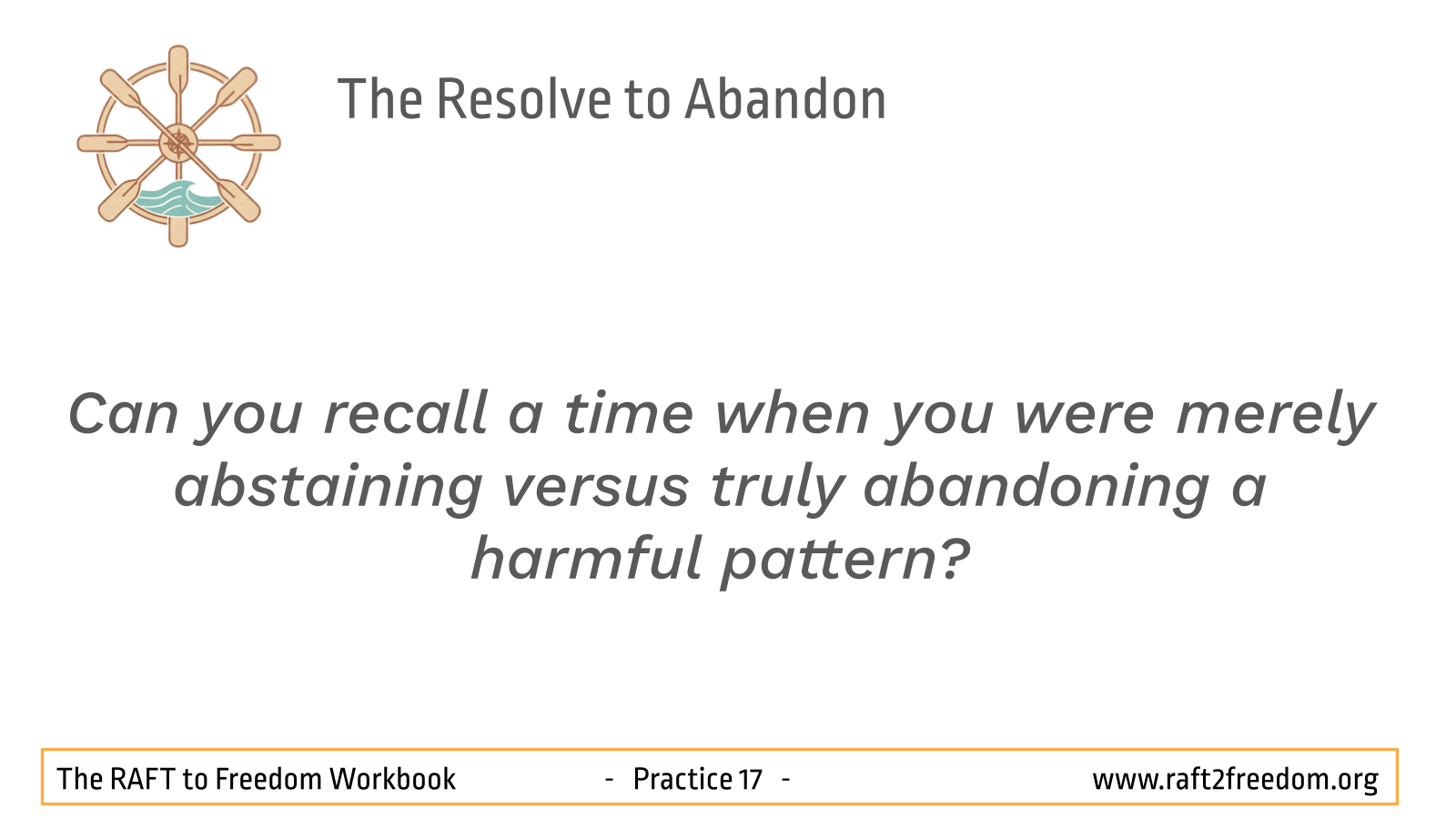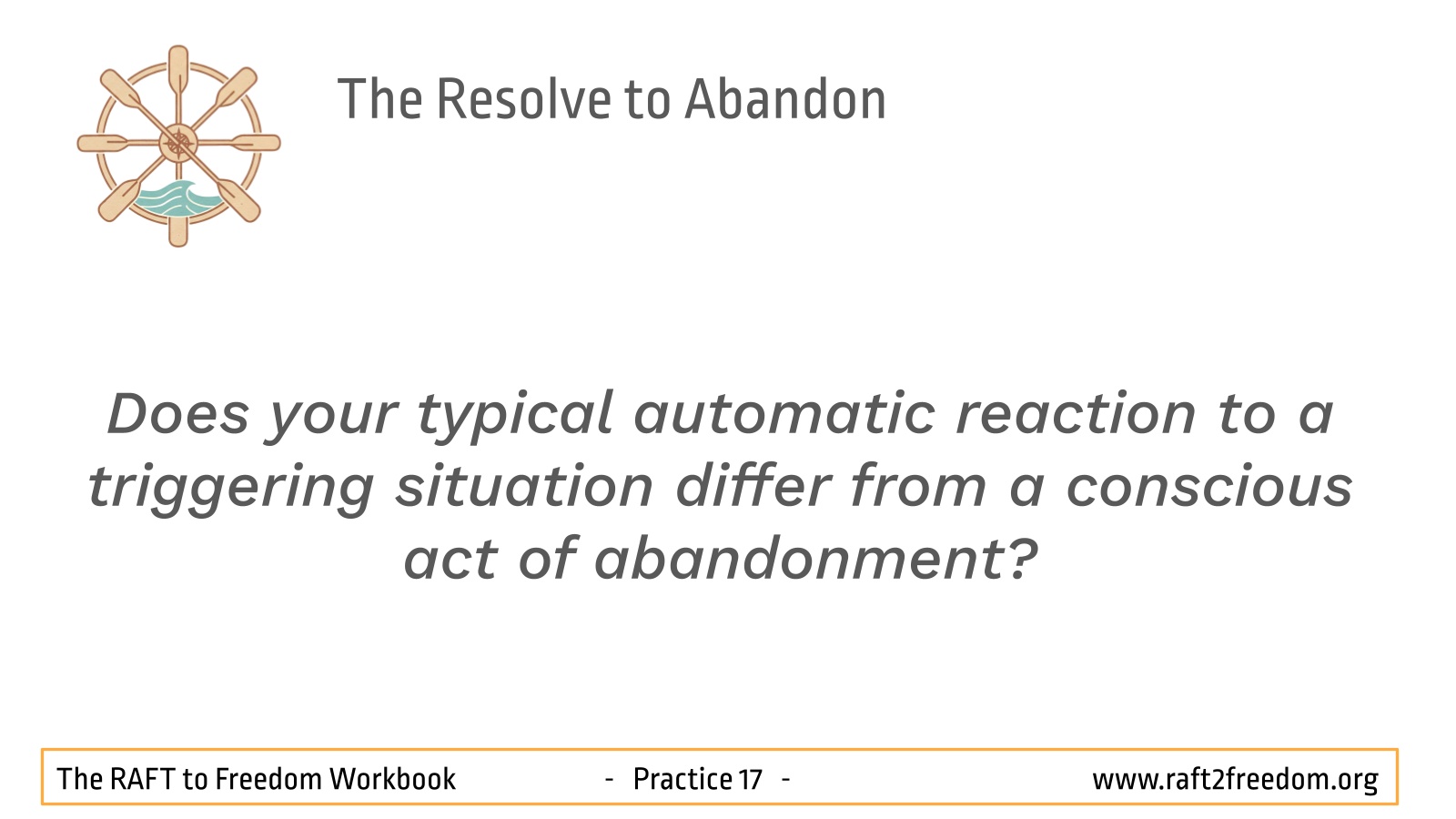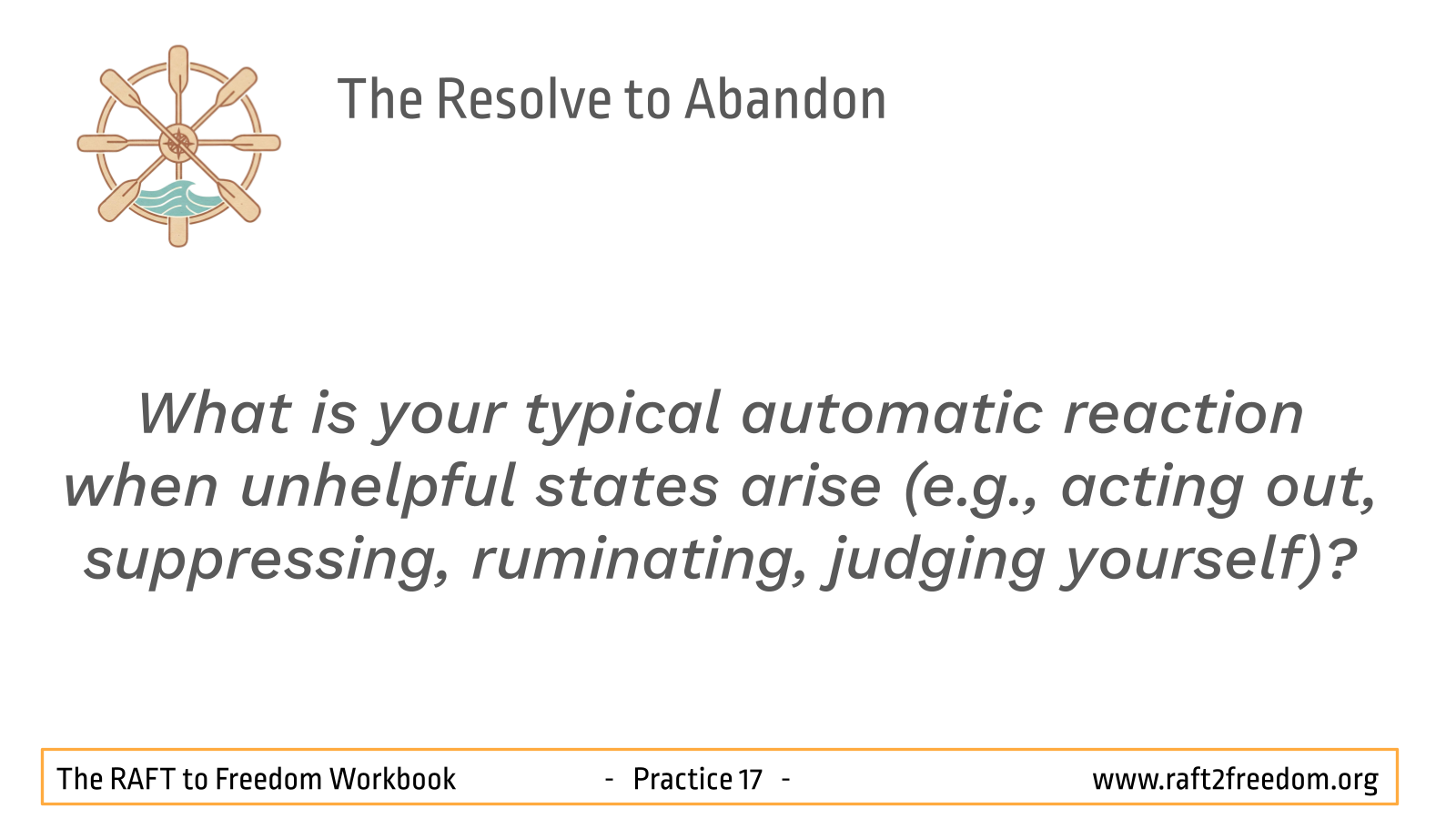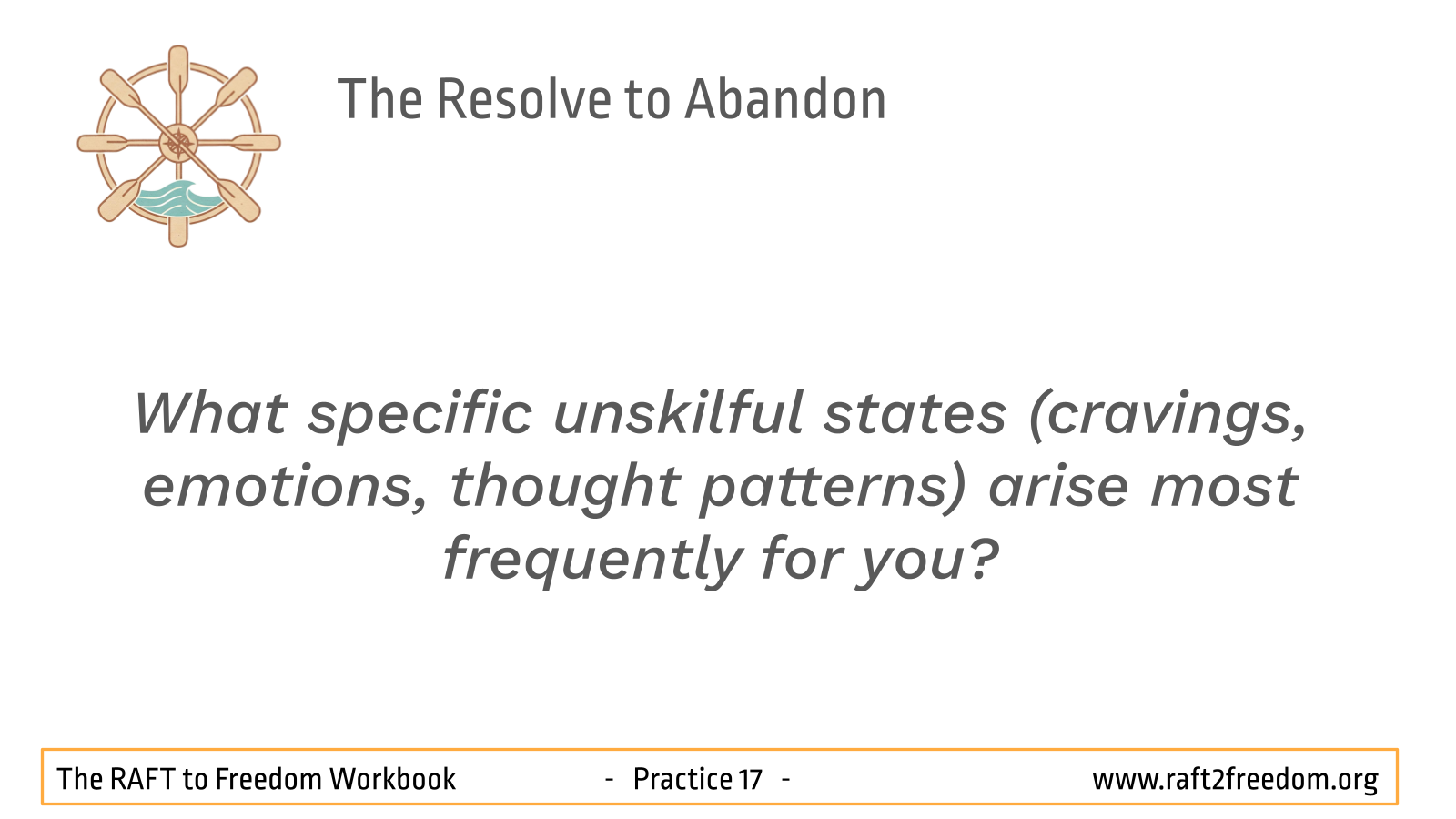Practice 17 – The resolve to abandon: skillfully letting go
Patching the leaks and bailing the water
“Let go of the past. Let go of the future. Let go of the present. Proceed to the opposite shore with a free mind, leaving behind all conditioned things.”
Thích Nhất Hạnh
“Freedom is the individual’s capacity to know that he is the determined one, to pause between stimulus and response and thus to throw his weight, however slight it may be, on the side of one particular response among several possible ones.”
Rollo May
“If you let go a little, you will have a little freedom. If you let go a lot, you will have a lot of freedom. And if you let go completely, you will have complete freedom.”
Ajahn Chah (paraphrased)

Episode 17 – From Abstinence to Abandonment
An AI-generated ‘deep dive’ into this aspect of the RAFT to Freedom
Following our exploration of the first resolve – the proactive effort to Prevent harmful states from arising – we now turn to its essential partner: The second resolve – Abandoning. This aspect of skilful effort addresses the reality that, despite our best preventative measures, unskilful states will inevitably arise. Cravings, difficult emotions, negative thought patterns, and habitual impulses are part of the human condition, particularly during our journey to liberation.
The second resolve guides us in making the conscious effort to abandon, overcome, remove, or dispel unhelpful states that have arisen, skilfully and compassionately. Gotama – the Buddha – defines the second resolve as: ” … generating the desire for the abandoning of unwholesome, unskilful qualities; making an effort, arousing energy, applying the mind, and striving.“
This is not about suppression or forceful repression, which often backfires, leading to more tension or later eruptions. Rather, abandoning here implies a skilful process of recognising the unskilful state clearly and understanding its harmful nature, applying appropriate techniques to let it go, weaken its hold, or transform its energy. It requires both diligence and wisdom.
It’s also helpful to remember the interconnectedness of the ‘Four Resolves’, as they form positive feedback loops. Successfully abandoning a harmful state strengthens our ability to maintain skilful ones and makes future prevention easier.
Abandoning, or skilfully letting go of harmful states that have already taken root within us.
This is more than merely abstaining from harmful behaviours. Abstinence, as we understand it, often implies a continued internal struggle, a feeling of “I can’t drink” or “I can’t use.“. It can feel like we are stopping ourselves from doing something we still desire, leading to a sense of misery or deprivation. In the early stages of our journey, many of us might experience this feeling, like a constant battle against our own passions and appetites.
However, the ‘intention to abandon’ calls for a deeper, more profound shift: it is about casting out, banishing, expelling, and rejecting freely and entirely our old way of life. This is akin to renunciation – a complete letting go that transforms our internal narrative from ‘I can’t drink’ to ‘I don’t drink’ and from ‘I can’t use’ to ‘I don’t use.’ This isn’t about mere suppression; it’s about adopting a new, desired way of life, leaving the old behind with a fresh ‘embodied intentionality’.
When we truly abandon, the effort becomes joyful and liberating, rather than a grim endurance test. We are no longer prisoners to our past, but free to move forward, whole-heartedly committed to our new way of being.
The burning torch: Unburdening for freedom
Imagine you are holding a burning torch in your hand. At first, it might seem useful or even exciting – perhaps it provides a fleeting light, a momentary warmth, or a sense of power. This torch represents your unwholesome cravings, addictions and compulsions.
As you continue to hold it, however, the flame begins to burn your skin. The heat becomes unbearable, the smoke stings your eyes, and the burning sensation intensifies. The very thing you thought was offering something useful is, in fact, causing you immense pain and suffering. It restricts your movement, demands your constant attention to manage the pain, and prevents you from truly engaging with anything else. You are consumed by the immediate discomfort.
Abandoning this unwholesome craving, compelling habit, or compulsion is like immediately dropping that burning torch.
The moment you let go, what is the immediate benefit?
- Instant relief: The searing pain stops immediately. There’s no gradual cooling; the source of the direct suffering is removed the instant you release your grip. This is the profound, immediate benefit of abandoning a compulsion – the direct cessation of the pain, anxiety, and self-harm it inflicts.
- Freedom of movement: With your hand no longer occupied and burning, you are free. You can use your hand to engage in wholesome activities – to steer your raft, to help others, to grasp nourishing food, or simply to rest. Your energy is no longer consumed by managing the pain or feeding the cravings.
- Clarity and calm: The smoke clears from your eyes, allowing you to see your path and surroundings with much greater clarity. The frantic internal struggle to manage the pain subsides, replaced by a sense of calm and presence.
- Healing begins: While the immediate pain is gone, the burn mark might remain for a while. However, with the torch dropped, true healing can now begin. This acknowledges that the consequences of past compulsions may linger, but the active harm has stopped, allowing wholeness to unfold.
The ‘burning torch’ simile vividly illustrates that clinging to our dangerous cravings, addictions and compulsions is an act of self-harm, and the most effective way to end that suffering is to simply ‘let go’. The benefits are not abstract future rewards, but the immediate, tangible relief and freedom that come from putting down what is actively burning us.
The RAFT metaphor: Patching leaks and jettisoning harmful cargo
In our RAFT metaphor, the Resolve to Abandon is about actively addressing the ‘leaks’ and ‘unwanted cargo’ that threaten to sink our vessel or pull us off course. When unhelpful states, like intense cravings, resentment, or self-criticism, arise (the water in the hull or heavy, unnecessary items), this resolve equips us to skilfully patch the leaks, bail the water, and jettison the harmful cargo. It is the active engagement of our faculties to restore the stability and direction of our RAFT to Freedom, ensuring we continue our voyage towards the safe shore.
As mentioned in the overview of the four resolves – the ‘Rahula Rules’ – Gotama gave advice to his son to abandon harmful states by encouraging continuous reflection. This wisdom encourages us to:
- Mindful reflection: Continuously assess our thoughts, words, and deeds before, during, and after we perform them.
- Ethical consideration: Ask if our actions lead to harm or benefit for ourselves or others. If they cause harm, we should abandon them. If they cause benefit, we can carry on.
- Learning from mistakes: If we realise an action was harmful, we are advised to acknowledge it, show restraint in the future, and grow from the experience.
We reflect: “Did that mental, verbal, or bodily action cause harm to me or others?“. If ‘yes’, then we should not do it again. If ‘no’, then it was a wise, helpful action. This teaching aligns perfectly with the act of abandoning: When we notice an arising unskilful state, we pause and ask: “Is what I’m about to say or do beneficial for myself and others?“. This creates the space for a conscious choice to abandon the unwholesome path.
How to Practice abandoning harmful states
“We are what we repeatedly do. Excellence, then, is not an act, but a habit.”
Aristotle
The work of abandoning is a moment-to-moment choice, an act of embodied intentionality that directs our energy away from unhelpful patterns. Here are ways we can actively Practice this:
- Mindful observation: Before we can abandon something, we must first clearly see it. This involves bringing a gentle, non-judgmental awareness to the arising of harmful states – whether they are cravings, difficult emotions, or unwholesome thoughts.
- Metacognition (thinking about our thinking): We can observe our thoughts as passing phenomena, rather than identifying with them. This helps us recognise that we are not our thoughts or cravings; they are simply mental events that can be observed and let go of.
- Creating the pause and choice: As Rollo May says above, our freedom lies in ‘the pause’. Between the arising of a harmful state and our automatic reaction lies a crucial ‘gap’ or ‘space’. This is where we can actively intervene with ‘clear comprehension’.
- Skilful Techniques:
- MARA (Mindful Awareness Responds Appropriately): Recognising Māra, the personification of our self-sabotaging nature, by naming it (“Māra, I see you – Māra, I know you!“) and then responding with mindful awareness and an appropriate heart-based response.
- SOBER (Stop, Observe, Breathe, Expand, Respond): A simple acronym to guide our response to triggers and urges.
- ELSA: A practical four-step process developed by Stephen Batchelor to help us meet life – especially difficult emotions and reactive habits – with clarity and compassion:
- E – Embrace: Turn toward the feeling or impulse with mindful acceptance. Rather than turning away or suppressing it, meet it with open awareness.
- L – Let Be / Let Go: Allow the reactivity to be present without fuelling it. Resist the urge to catastrophise, justify, or cling to old stories. Simply let it be, without feeding the fire.
- S – See the Stopping: Notice the natural pause – the moment the reactivity loses momentum. This stopping is a moment of freedom, a glimpse of non-reactivity – the absence of craving, aversion and confusion.
- A – Act: From this stillness – free from craving, aversion, and confusion – choose a skilful, compassionate, and creative response rather than a habitual reaction.
- Right Now, It’s Like This (RNILT): This phrase encapsulates the essence of ‘radical acceptance’ and ‘present-moment awareness’ – key aspects of both early Buddhist teachings and mindfulness-based recovery programs. It is often used as a mantra or pause phrase to interrupt automatic reactions (for example, difficult emotions, cravings, aversions and compulsive thoughts). It acknowledges challenging or unpleasant experiences without judgment, allowing us to reconnect with the reality of our present moment, as it is, not as we wish it to be.
RNILT – meditation or reflection use:- Sit quietly and bring attention to the breath.
- Notice what arises – thoughts, sensations, feelings.
- For each, say gently:
- “Right now, it’s like this.”
- No need to change it, fix it, or make it go away.
- Urge surfing: Riding the wave of a craving or intense emotion, knowing it will eventually pass, rather than being overwhelmed by it.
- Replacement: Actively replacing unwholesome thoughts or behaviours with wholesome ones. For example, physical exercise, meditation, creative hobbies, or connecting with a supportive community.
- Reframing: Challenging and reinterpreting thoughts that fuel our compulsive patterns or justifications. An example could be the shift from “I can’t handle this craving” to “This craving will pass, and I am stronger than it.”
- Learning from experience: Each time we successfully abandon a harmful state, we reinforce new neural pathways in our brain, strengthening our capacity for skilful choice.
Integrating Portia Nelson’s ‘Autobiography in five short chapters’
In the chapter on ‘mindfulness with clear comprehension’ (chapter 10), we explored Portia Nelson’s poignant poem that beautifully illustrates the journey from unconscious repetition to conscious letting go, mirroring our path from a life of bondage to freedom; the journey from abstinence to abandonment:
- Chapter I: “I fall in. I am lost… I am helpless. It isn’t my fault.” This represents the initial stage of unwitting engagement with harmful patterns, feeling overwhelmed and powerless.
- Chapter II: “I pretend I don’t see it. I fall in again. But it isn’t my fault.” Here, we might be in a state of abstinence, avoiding but not truly letting go, still blaming external factors, still bound by habit.
- Chapter III: “I see it is there. I still fall in… it’s a habit. My eyes are open. It is my fault. I get out immediately.” This shows the dawning sajjaof awareness, taking responsibility, and the rapid shift away from the harmful pattern, even if the habit still exerts some pull.
- Chapter IV: “I walk around it.” This is a significant step towards genuine abandonment; we see the hole, understand its nature, and skilfully navigate around it. In the ‘gap’ or ‘pause’ between stimulus and reaction, we actively choose a different response.
- Chapter V: “I walk down another street.” This is the ultimate stage of abandonment – a complete shift in our way of life. We no longer even visit the street where the hole exists; we have renounced the old path entirely and chosen a new, wholesome direction. This is the essence of true abandonment and the profound liberation it offers.
‘Sajja’: The unwavering resolve to let go
As discussed in the overview of the four resolves the practice of ‘sajja’ encompasses truth, truthfulness, and a personal vow or vows, that signify a deep-seated promise to ourselves – being true to ourselves – to abandon harmful behaviours and to cultivate and embrace a new life. For our purposes, we can look at ‘sajja’ as two types of resolve:
- Primary ‘sajja’: The one that patches up the biggest hole in our raft is our commitment to abandon our most damaging craving or compelling habit.
- Personal ‘sajja’: Personal ‘sajjas’ or resolves patch up the smaller but still very troublesome holes in our raft. As well as acting in the service of keeping us on course – and preventing us from falling overboard – they help us to step out of a perpetrator and/or victim self-identity and they support our cultivation of healthy boundaries and in being true to ourselves.
On our journey to the safe shore, we are often faced with internal struggles and impulses that have already arisen, pulling us back towards old patterns of suffering. In Chapter 16, we began to explore the profound concept of Sajja, understanding it as a deep commitment to the truth of how things really are and as a fresh start, which is a powerful engine for our moving from suffering to freedom, as famously recognised at Wat Thamkrabok Monastery. Now, as we delve into the Resolve to Abandon unskilful qualities and cravings, we can see how Sajja provides the unwavering internal compass and strength to truly let them go. This isn’t about mere suppression; it’s about a conscious, embodied intention that empowers us to release what no longer serves our well-being.
Sajja, in its multifaceted wisdom, offers us powerful means to accomplish the difficult work of abandoning. It strengthens our capacity to let go of harmful states and compulsions once they have manifested, guiding us away from merely trying to control them towards a profound release.
The unwavering resolve, born of our embodied ‘Sajja’, allows us to bravely face and compassionately release the specific manifestations of craving, ill-will, or any other unskilful quality that has arisen within our experience. It transforms into an internal ‘no‘ that springs from a deep ‘yes‘ to healing and freedom, helping us to continually abandon those very elements that bind us to suffering – that tie us to the dangerous shore.
Sajja: A dynamic vow for letting go
The power of a vow and being true to ourselves is a foundational resolve. While our primary ‘sajja’ serves as a powerful initial commitment to a new way of life, its role in the Resolve to Abandon is equally profound. Here, Sajja transforms from a singular declaration into a continuous, active reinforcement of letting go of harmful states and destructive habits that have already arisen.
We can think of our personal ‘sajja’ as a constant compass for our raft. When unhelpful cravings, resentments, or old thought patterns surface – the ‘water in our hull’ or ‘unwanted cargo’ as we discussed – our ‘sajja’ becomes the inner voice that guides us to actively release them. It’s the moment-to-moment choice to reaffirm our commitment to freedom and consciously detach from what no longer serves us.
How Sajja supports abandoning in practice:
- Reinforcing the “I don’t drink/use” narrative: The transition from “I can’t” (abstinence) to “I don’t” (abandoning) is where our primary ‘sajja’ truly shines. By regularly remembering to remember, and embodying our vow – for example, “I will not take drugs or alcohol for the rest of my life”, “I will not gamble”, “I will not shop for things I don’t need” or “I will not eat solely for comfort.” – we are actively rewiring our brain. Each repetition strengthens the neural pathways that support our new, desired way of life, making the old patterns less compelling and easier to abandon. This conscious affirmation helps us to prune the superhighways for old habits in our brain, as discussed in the neuroscience section.
- A ‘guardrail’ against relapse justifications: Unskilful states often arrive with justifications or persuasive internal stories – Mara’s coercive narrative. Our personal ‘sajja’ acts as an internal firewall, providing a clear, pre-established boundary against these insidious thoughts. When a craving whispers, “I deserve this,” your ‘sajja’, deeply committed and repeatedly affirmed, can be the unyielding reply: “I will not look outside of myself for happiness” or “I will not let others make me suffer” or even “I know you, Mara!”. It’s a direct application of the ‘Respond mindfully – don’t react automatically!’ principle.
- Empowering the pause and choice: The ‘gap’ or ‘pause’ between stimulus and response, so vital for our mindful choice, is fortified by ‘sajja’. When we pause, our ‘sajja’ serves as a reminder of our deepest values and intentions. It enables us to consciously choose to abandon the unwholesome path and align our actions with our highest aspirations, rather than impulsively reacting to the craving or arisen state.
- Cultivating wholesome counterparts: As we learn to identify an unskilful state, ‘sajja’ can guide us toward cultivating its wholesome opposite. For instance, if self-criticism arises, a ‘sajja’ like “I will love myself just as I am right here, right now” or “I will not love anyone more than I love myself” actively promotes self-compassion, helping us to abandon the critical thought by replacing it with a kinder internal dialogue. This aligns with the psychological principle of replacing unwholesome behaviours with wholesome ones.
- While prevention (chapter 16) is about guarding the gates, ‘sajja’ in the context of abandoning is about actively choosing not to engage with unwelcome visitors who have already entered your inner city, and instead, to firmly escort them out. It transforms the struggle into a liberating act of aligning with our true, resolved selves.
Self-Reflections
Reflect on your experience with arisen unskilful states and the journey from abstinence to abandonment:
- What specific unskilful states (cravings, emotions, thought patterns) arise most frequently for you?
- What is your typical automatic reaction when unhelpful states arise (e.g., acting out, suppressing, ruminating, judging yourself)?
- Does your typical automatic reaction to a triggering situation differ from a conscious act of abandonment?
- Can you recall a time when you were merely abstaining versus truly abandoning a harmful pattern?
- Is there a difference between abstinence and abandonment in your internal experience and sense of freedom?
- Which of the techniques mentioned above (e.g., urge surfing, MARA, SOBER, ELSA, RNILT, replacement, reframing) feels most potentially helpful or accessible to you for abandoning a specific pattern?
- Which abandoning technique feels most challenging?
- How does self-criticism affect your ability to work skilfully with difficult states when they arise?
- How might embracing abandonment – renunciation, as a liberating choice, rather than a deprivation be helpful to you?
- Have you ever consciously tried to ‘abandon’ or ‘let go’ of a compelling craving? What was that experience like?
Journaling Prompts
Use writing to explore the Practice of abandoning and the shift from abstinence:
- Track and respond: Choose one specific unskilful state you’d like to work with. For the next few days, note when it arises. Then, consciously choose one technique (for example, MARA, SOBER, ELSA, RNILT, mindful observation, replacing with kindness) and apply it. Write about the process – what happened, how it felt, what you learned.
- From can’t to don’t: Reflect on a harmful behaviour you’ve stopped. Was it a struggle of “I can’t do this,” or has it transformed into a clear “I don’t do this” because you’ve genuinely abandoned the old way? Describe this shift in your journal.
- Consequence reflection: When a strong craving or negative thought pattern arises, take a moment to write down the likely short-term and long-term consequences of acting on it versus abandoning it.
- Walking another street: Reflect on Portia Nelson’s poem. Where do you see yourself in that progression regarding a specific habit or pattern? What would it feel like to truly ‘walk down another street’ in your life, completely abandoning the old path?
- Self-compassionate abandonment: Recall a recent time you struggled to abandon an unskilful state or perhaps acted on it. Write yourself a compassionate letter acknowledging the difficulty, validating the struggle (without condoning harmful action), and reaffirming your resolve to keep practising from a place of abandonment, not deprivation.
- Opposite qualities: Identify an unskilful state you experience (for example, self-hatred, shame and resentment). What is its wholesome opposite (for example, forgiveness, self-compassion and appreciation)? Write about one small way you could intentionally cultivate that opposite quality today.
Supporting Material: Scientific and philosophical perspectives
For those interested in the scientific and philosophical underpinnings of the Resolve to Abandon, the following overview highlights some key connections. The wisdom of abandonment is echoed in modern science and philosophy, offering deeper insights into why this shift is so transformative:
The process of abandoning unskilful states is supported by various fields:
- Neuroscience: Abandoning involves overriding habitual, often dopamine-driven, reward pathways (basal ganglia) with conscious control from the prefrontal cortex (PFC). Techniques like mindful observation without acting (‘urge surfing’) may engage extinction learning, gradually weakening the stimulus-response link. Cognitive reframing recruits higher PFC functions to reappraise stimuli. Cultivating opposite states (like compassion) activates different neural networks associated with affiliation and reward, competing with stress/craving circuits.
When we repeatedly engage in harmful behaviours, neural pathways in our brain become deeply ingrained, almost like superhighways for old habits. True abandonment – the consistent choice to “walk down another street” – actively works to prune these old pathways and strengthen new, healthier ones through neuroplasticity. This isn’t just about resisting an urge (which still keeps the old pathway active to some degree); it’s about shifting our brain’s inclination over time. The prefrontal cortex (PFC), responsible for impulse control and goal-directed behaviour, is crucial here, overriding more automatic, habitual responses. With repeated effort in abandoning old patterns, we literally rewire the brain towards freedom. Emotional regulation networks involving the PFC, amygdala, and insula are strengthened through these practices.
- Psychology: Cognitive Behavioural Therapy (CBT) provides tools for identifying, challenging, and changing unhelpful thought patterns (abandoning cognitive distortions). Dialectical Behaviour Therapy (DBT) offers skills for distress tolerance (surviving crises without making things worse) and emotion regulation (changing unwanted emotions). Acceptance and Commitment Therapy (ACT) teaches acceptance of difficult private experiences (observing without struggle) and cognitive defusion (seeing thoughts as thoughts, not commands), facilitating non-attachment and value-based action. Exposure Therapy principles apply – facing urges/emotions without the usual escape behaviour weakens their power.
Strategies for staying safe (relapse prevention models) models often focus on coping skills and self-efficacy, but true abandonment aligns with deeper cognitive behavioural strategies that challenge and reframe unhelpful thoughts. This directly parallels the Buddhist focus on examining and letting go of unwholesome thoughts. From the perspective of Acceptance and Commitment Therapy (ACT), abandonment is about disengaging from unworkable patterns of behaviour and aligning actions with core values, fostering psychological flexibility. It signifies a move from “avoidance coping” to a more active, values-driven engagement with life, much like the Buddhist emphasis on taking appropriate action aligned with truth.
- Philosophy: Concepts of detachment and letting go are central to many traditions (for example, Buddhist nekkhamma, Stoic apatheia). Virtue ethics emphasises overcoming vices (unskilful states) through practice. The exercise of free will or volition in choosing responses over habitual reactions is a key philosophical theme. Examining the nature of desire and its role in suffering is common across many schools of thought.
The concept of abandoning resonates strongly with the Buddhist principle of renunciation and the act of “letting go” of clinging. This is distinct from mere suppression, which often maintains the underlying desire. Philosophical traditions often explore the idea of true freedom not as the absence of external constraints, but as liberation from internal attachments and compulsions. By intentionally abandoning harmful states, we exercise genuine agency and commitment to living a virtuous life, reflecting principles of virtue ethics and a profound, embodied commitment to truth (Sajja) that transcends mere promises or external rules. As Gotama’s journey highlights, true freedom requires courage to leave behind even comfortable, conditioned experiences in pursuit of unconditioned peace.
Remember to Remember
“True freedom is not achieved through the absence of desires,
but through the mastery of them.” ~ Aristotle
This second of the four resolves, the Resolve to abandon harmful states – is where the active work of transformation truly happens. It acknowledges that challenges will arise on our journey, but it equips us with skilful means to meet them without being overwhelmed or drowning. This is not about battling against ourselves, but about a liberating release of the old, in favour of the new. It requires courage, patience, self-compassion, and the willingness to apply mindful effort repeatedly. The careful attention that we cultivate during mindfulness of breathing, is a precursor for the moderated intention we apply to the four resolves. This practice is crucial for recognising our capacity for change and directly relates to the core task in our next leg of this journey – the ‘A’ of Abandoning in our RAFT acronym.
By learning to skilfully patch the leaks, bail the water, and jettison the harmful cargo from our raft, we keep our vessel afloat and moving towards the safe shore. Having addressed Prevent and Abandon, we next turn to the positive construction: Cultivating the skilful states that actively support our well-being and propel us further on our voyage.
Sutta References
- Sammappadhana Vibhanga Sutta (SN 45.8) / Anguttara Nikaya 4.13 & 4.14: Define the Four Right Efforts, including the second.
- Summary: These texts define the second effort as generating desire and exerting intent “for the abandoning of evil, unskilful qualities that have arisen.”
- Vitakkasanthana Sutta (MN 20 – The Relaxation of Thoughts): Offers five specific methods for abandoning unwholesome thoughts.
- Summary: Provides techniques like replacing the thought, examining its danger, ignoring it, stilling its formation, and suppressing it—all methods of abandoning.
- Sammaditthi Sutta (MN 9 – Right View): Helps identify what is unwholesome (to be abandoned) and wholesome (to be cultivated).
- Summary: Defines unwholesome roots (greed, hatred, delusion) and actions stemming from them, contrasting them with wholesome roots and actions.
- Anapanasati Sutta (MN 118 – Mindfulness of Breathing): Links breath awareness to abandoning.
- Summary: Includes the training “He trains thus: ‘I will breathe in observing abandoning’; he trains thus: ‘I will breathe out observing abandoning,’” suggesting mindfulness itself facilitates letting go.
- Nivārana Suttas (e.g., SN 46.51, SN 47.12): Discuss the Five Hindrances as primary obstacles to be abandoned.
- Summary: Identify sensual desire, ill will, sloth and torpor, restlessness and remorse, and doubt as key mental hindrances that obstruct concentration and wisdom, emphasising the need for their abandonment.
- Ambalatthika-rahulovada Sutta (MN 61): Teaches reflection before, during, and after actions to ensure they are wholesome.
- Summary: Advises Rahula to repeatedly reflect on bodily, verbal, and mental actions to determine if they lead to harm for self or others, abandoning those that do and cultivating those that don’t.
- Dhammacakkappavattana Sutta (SN 56.11): Presents the Four Noble Truths, with the first step being acknowledging suffering (similar to surrendering to the truth of addiction).
- Summary: The Buddha teaches that acknowledging the truth of suffering (dukkha) is the first step towards its cessation, underscoring the necessity of facing reality without denial before transformation can occur.
- Maha-Rahulovada Sutta (various suttas where the Buddha instructs Rahula, including MN 62): Links developing positive states to abandoning negative ones.
- Summary: Encourages developing meditations like loving-kindness to abandon ill-will, compassion to abandon cruelty, and appreciative joy to abandon resentment, demonstrating a direct path to transforming unwholesome states.
- Dvedhavitakka Sutta (MN 19 – Two Kinds of Thought): Discusses cultivating wholesome thoughts and abandoning unwholesome ones.
- Summary: The quote “Whatever a person frequently thinks and ponders upon, that will become the inclination of their mind” highlights the power of intentional thought in this process.
| RAFT to Freedom © 2025 by Dr Cathryn Jacob and Vince Cullen is licensed under Creative CommonsAttribution-NonCommercial-ShareAlike 4.0 International. |
